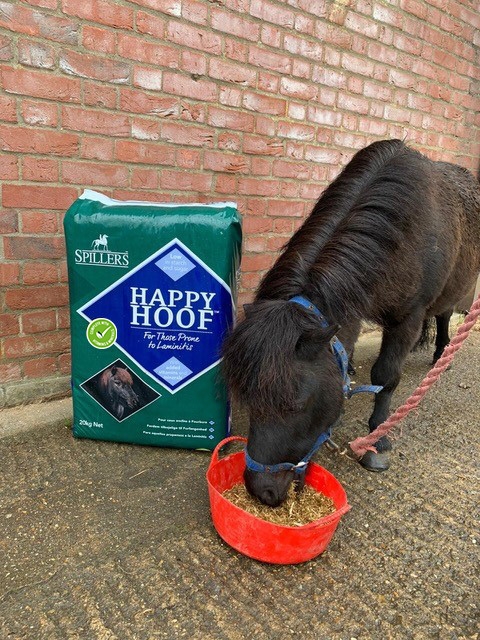
The Makers Of SPILLERS Want Your Happy Memories Of HAPPY HOOF
Back in the year 2000, SPILLERS™ HAPPY HOOF™ broke new ground as the first complete fibre feed for those prone to laminitis. Now, the feed brand is asking horse owners to share their happiest memories of this iconic product during the past two decades. Visit https://www.spillers-feeds.com/heritage to tell your HAPPY HOOF story.
Over the years SPILLERS HAPPY HOOF has seen several pack and formulation adjustments. Highlights include the launch of SPILLERS HAPPY HOOF Molasses Free in 2017 and the introduction of even lower sugar and starch levels to both products in 2020.
What makes SPILLERS HAPPY HOOF extra special is that it has evolved in tandem with ground-breaking research on laminitis and associated metabolic diseases. The makers of SPILLERS, via the WALTHAM™ Equine Studies Group and collaborators in universities around the world, have published more than 100 scientific papers relating to laminitis and obesity over the past 20 years. Some of the most important work includes:
2001: The first of an ongoing series of studies at Virginia Tech in the US looked at the effect of diet on insulin dynamics.
2003: A key paper looked at how to detect tissue insulin resistance and found insulin resistance can be linked with obesity as well as the core diet. This led to research on insulin resistance in different breeds and in response to different diets.
2005: A paper showed that feeding thoroughbred weanlings a very starch and sugar rich diet could make them more insulin resistant than if they were fed on an oil and fibre rich diet.
2007: A UK based study looked at potential ‘screening tests’ that could help to identify horses and ponies at greater risk of developing laminitis. Another paper investigated the link between breed, insulin resistance and the risk of laminitis.
2009: A key paper described the cresty neck score for the first time. A linked paper discussed potential ways of using this and other markers to predict the development of pasture associated laminitis.
2010: The first of many studies looked at ways of safely managing weight loss in obese ponies, aiming to help reduce the risk of laminitis and other obesity-related health concerns.
2011: The first of several studies investigated how best to soak hay to reduce the ‘sugar’ content.
2012: A study showed, for the first time, that some horses and ponies are very resistant to losing weight.
2015: Research showed that more dominant animals were more likely to become obese. Later work showed that dominance is not necessarily the main factor; those most likely to gain weight tend to eat more and are less distracted.
2016: Grazing muzzles were found to reduce grass intake by an average of 80% in ponies turned out for three hours, regardless of the season. This was one of a series of studies evaluating the use of grazing muzzles in ponies.
2017: The first prospective study identified that a high concentration of insulin and a low concentration of adiponectin (a hormone produced by fat cells) could predict a greater risk of laminitis in previously non-laminitic ponies, in the following months or even years. Another study found that a recent change in grazing, access to ‘high quality grazing’ and being a cold-blooded breed less than 149cm in height were significant risk factors for laminitis, regardless of the season.
2021: This recent study showed that strip grazed ponies gained significantly less weight compared to ponies given free access to a restricted amount of grazing over a 28-day period.
2022: A long term study categorised ponies as low, medium or high risk of going on to develop laminitis, by measuring the concentration of insulin in their blood pre and post an oral sugar test. This paper showed for example, that whilst ponies with a lower level of insulin in their blood could still develop laminitis, they were much less likely to suffer from this potentially devastating condition.
“Laminitis and obesity are issues close to our hearts and are at the forefront of our research programme,” said Sarah Nelson, Product Manager at Mars Horsecare, home of the SPILLERS brand. Our work is ongoing; we are currently focussed on trying to learn how best to manage starch and sugar intake in horses and ponies at risk of laminitis. Watch this space!”
To find out more about the SPILLERS range contact our Care-Line on + 44 (0)1908 226626 or visit www.spillers-feeds.com.
More from Spillers
- Feed brand invites horse owners to ‘Play Your Calories Right’ and win £250
- Feed manufacturer’s survey uncovers equine weight management obstacles
- Feed brand to donate to Redwings for every new Club member
- Win fame and free feed with leading equine nutrition brand
- Mars Horsecare appoints new Global Science & Nutrition Director

 3 years ago
3 years ago  1269 views
1269 views
 2 weeks ago
2 weeks ago 